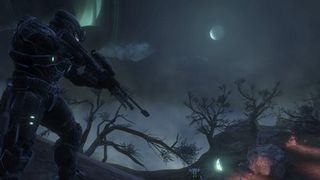Beyond the activities of the Spartan team, Human marines help fill out the warzones. Responding to criticism of the vocally colourful but visually bland marines in Halo 3, Bungie has given the UNSC forces on Reach a makeover with a level of detail reminiscent of Ghost Recon. You’ll be able to recognise different types of soldiers, and they’ll sport different combinations of equipment and armour.

Raising the realism still further, for the first time in a Halo game some of the human models are animated using motion-captured actors. Even facial animation – something that hasn’t exactly been a strong point of the series so far – has been given the motion capture treatment, and the Spartans will remove their helmets and reveal a level of emotional authenticity that would turn Master Chief green with envy.
The traditional hand animation style is still used in many instances, but the benefits of motion capture are clear from the moment you see models walking across the screen, stepping over rocks and transitioning between states without looking like they’ve shat their space-age pants.
From a shaky handheld camera effect in the cut-scenes to soggy clods of earth raining down after a grenade explosion, it’s clear that Reach leaves no part of Halo 3 untouched. Bungie’s oft-stated plan is for a game that evokes the best moments of the original Halo: Combat Evolved, but while fans may well have been satisfied by a new ten-hour Campaign, better graphics and a fresh set of online modes, Reach looks set to go quite a bit beyond that.

The launch of the multiplayer beta should give us a better idea of how different it’s going to be, and it will certainly satisfy us as to exactly how much, since the launch of Halo 3, the release of three hugely successful Call of Duty titles has affected the Bungie team’s way of thinking.
Feb 26, 2010
